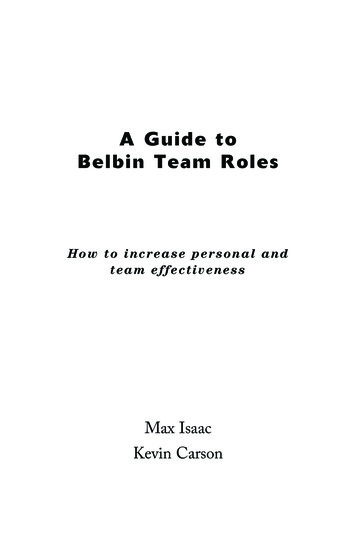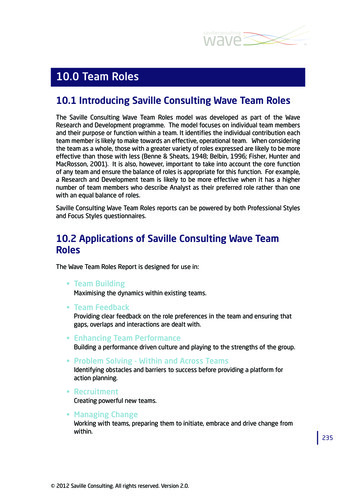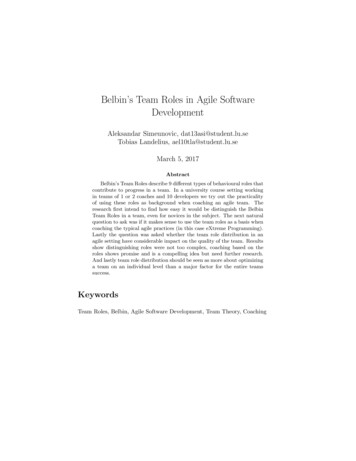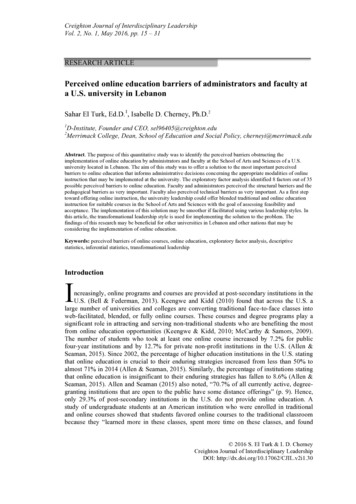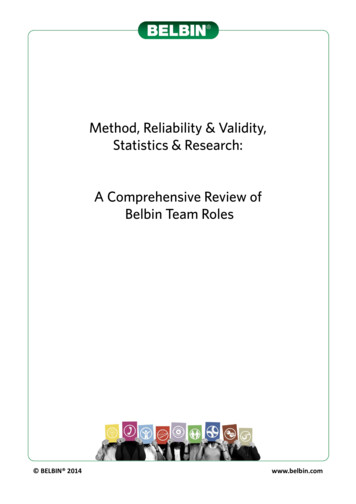
Transcription
Method, Reliability & Validity,Statistics & Research:ACComprehensiveh i ReviewR i offBelbin Team Roles BELBIN 2014www.belbin.com
ContentsIntroduction – Measuring Behaviour1Construction of the BTRSPIIs the BTRSPI an ipsative test?34Administration and Scoring of the BTRSPIWhy use Interplace?The Specialist RoleObserver AssessmentsNormingTeam Role Advice666788Description of the Nine Team Roles9ReliabilityTest‐retest reliabilityInternal consistency111111Face validityC t t validityConstructliditConvergent validityDiscriminant validityConcordant validityThe BTRSPI and other measuresCriterion validityBelbin in practiceObserver AssessmentsAssessing a job in terms of Belbin Team RolesBelbin in industry131313131414151516161719ValidityTesting, Bias and FairnessBelbin and GenderBelbin and Different LanguagesBelbin and AgeBelbin and Management2020212122Further ReadingBooks from BelbinOther titles from BelbinResearch StudiesRecommended ArticlesOther Articles232323242526 BELBIN 2014www.belbin.com
Introduction - Measuring BehaviourThe Belbin Team Role Self‐Perception Inventory (BTRSPI) was designed to measure behaviouralcharacteristics which individuals display when working in teams. Belbin Team Role Theory was devised as aresult of the studies conducted by Meredith Belbin in the 1970s. For more details of this initial research,please visit the Belbin website.Since the BTRSPI measures behaviour rather than personality, it is not considered to be a psychometric test(those which measure attributes of personality).personality) Rather,Rather personality is one of many factors which caninfluence behaviour. Other factors include internalised values and motivations, and the external workingenvironment or “Field ingBEHAVIOURExternalinfluencesValues andmotivationsExperienceWhilst most personality traits are acknowledged to be fairly constant, behaviour can change more readily,adapting to changes in any of those factors which influence it. As a result, Belbin expects that Team Rolepreferences might change over time. Whilst it is unlikely that an individual’s Team Roles will changedramatically or be reversed altogether, some alterations are expected, in line with a change of job role orwork environment, or as a result of a major life change.The BTRSPI measures behaviour because Belbin believes that this provides the most useful and verifiablei finformationi regardingdi an individuali di id l to a recruiter,imanager or consultant,las wellll as to theh individuali di id lconcerned. Whilst it could be argued that only the individual himself knows his own personality, behaviouris observable and can be interpreted and used to predict future reactions and conduct.The difficulty when measuring personality alone is that there may be a large discrepancy betweenpersonality and behaviour. Whilst an individual may purport to be an extravert, that person’s behaviour inthe workplace may lean towards introversion. The individual’s self‐perception of extraversion may indicatelimited self‐awareness or may reflect a personality trait the individual wishes to possess. It is arguable thatidentifying certain personality traits does not directly help the manager concerned with recruitment orpromotion. In the case of many psychometric tests, managers expend much energy understanding thepsychometric dimensions or traits, rather than applying the knowledge to improve performance.Rather than providing information regarding individual personality traits, the BTRSPI gauges behaviour inorder to identify groupings or clusters (Team Roles) which characterise an individual’s behaviouralcontribution to the workplace. For example, you might find a question in a personality test along the linesof: “When I’ve made a decision about something, I still keep wondering whether it’s right or wrong.” Here,the focus is on how the individual thinks and feels.feels By contrast,contrast the BTRSPI asks questions like: “II can berelied upon to finish any task I undertake,” focusing on practical contributions an individual might make.Page 1 of 26 BELBIN 2014www.belbin.com
As well as self‐reporting, whereby an individual identifies behaviours he believes he exhibits, the BTRSPIuses Observer Assessments ((OA)) to substantiate or refute these claims with the pperceptionspof colleagues,gmanagers and other co‐workers, to form a more rounded view of the individual’s contribution. Aritzeta,Swailes & Senior write:The dynamic configuration of team roles measured by the [B]TRSPI and therelative stability of traits measured by personality questionnaires leads to theconclusion that traits measured byy the latter are different from those measuredby the [B]TRSPI. Thus, both instruments may be tapping different butcomplementary constructs. Aritzeta, Swailes & Senior, 20071Many individuals and organisations are concerned that the introduction of psychometric tests might lead to“pigeonpigeon‐holingholing” or labelling of individuals.individuals With Belbin Team Roles,Roles the relationship between an individualand the Team Roles they exhibit is a far more complex one. An individual does not have one Team Role, buta combination of preferred, manageable and least preferred roles. The distribution and interrelation ofthese roles, as shown in an individual’s report, have a great influence on the way the roles will be played outin practice and experienced by others. Whilst an individual may claim to prefer or enjoy a particular role, itdoes not necessarily mean that they can or should play only this role. The theory of Team Roles isconcerned with acknowledging strengths and weaknesses, but also with cultivating strengths to becoming amodel, strong example of a given Team Role type.1Belbin’s Team Role Model: Development, Validity and Applications for Team Building (Aritzeta, Swailes &Senior, 2007), p. 110.Page 2 of 26 BELBIN 2014www.belbin.com
Construction of the BTRSPIThe BTRSPI is a behavioural test designed for use in organisational and work settings. The BTRSPI wasformulated by Meredith Belbin in the 1980s following on from his research at Henley Management Collegeand inception of Team Role Theory.The BTRSPI measures nine dimensions or Team Roles and has one scale known as Dropped Points (DP),which measures claims about oneself rather than valid Team Role contributions. The inventory consists ofeight sections, with each section containing a heading and ten statements, one item per Team Role and atenth item representing DP.The headings give a work‐based scenario or situation with which the individual can identify. This is intendedto anchor the behaviours described in a familiar work context and to encourage candidates to reflect anddraw on examples from their own experiences.When completingWhl ti theth BTRSPI,BTRSPI candidatesdid t are askedk d tot distributedi t ib t tent marksk ini totalt t l per sectionti off thethinventory. If a candidate identifies equally with only two statements, 5 points should be allocated to each ofthe two statements. If four of the statements are relevant, but two more so than the other two, theallocation of points might be 3, 3, 2 and 2, as shown below:This is then repeated for each section of the inventory. Candidates may only allocate marks in wholenumbers and are asked to avoid either extreme (allocating all 10 marks to one statement or 1 mark to each)where possible.Page 3 of 26 BELBIN 2014www.belbin.com
Is the BTRSPI an ipsative test?The BTRSPI is designed to ascertain as much information as possible about an individual’s Team Rolepreferences, whilst keeping the inventory manageable in terms of item length, inventory length andanswering style. Many psychometric tests such as the 16PF and OPQ require the respondent to evaluatearound 200 items using a Likert scale (e.g. ticking an answer along a spectrum from “Strongly agree” to“Strongly disagree”, usually with a neutral option of “Don’t know” or “Not sure”). In contrast, the BTRSPIasks the respondent to consider items within each section in relation to each other and to prioritise someabove others. As a result, the questionnaire takes only between 15 and 20 minutes to complete, less timethan many psychometric evaluations.evaluationsSince the total score achieved in the BTRSPI is always constant, it is an ipsative measure overall. This meansthat a respondent must express a relative preference between two or more statements measuring differentcharacteristics, thus creating a degree of interdependence between the characteristics being measured.However, since the items are dispersed in the 8 sections such that there is one item for each role in eachsection, the scores given to items for any Team Role are not fully ipsative, since they do not sum to aconstant value. Whilst the scores for items in the same scale are independent of each other, they are partlydependent on the scores given to other scales. In other words, the BTRSPI is ipsative within its sections(since scores always sum to 10) but not between its sections.Some early research studies criticised the scoring style of the BTRSPI, suggesting that it “forced choice”between statements. In 1993, Meredith Belbin defended the inventory, claiming that “some restriction ofchoice [was] operationally desirable” since “self‐rating on independent scales yields little of value inindustrial and occupational settings” (see discussion above).In their 1998 research, Sommerville & Dalziel converted the BTRSPI to a Likert‐type scale questionnaire.They found that 73% of participants had the same Team Role across both versions of the test, indicatingthat there is no significant difference in the prediction of Team Roles between the two versions. 2In 1993, Meredith Belbin maintained that Likert‐type scales caused more frustration among candidates inindustry and later, in research conducted in 2004, Aritzeta, Swailes & McIntyre‐Bhatty point out that Likert‐type scales bring their own set of problems:There is a strong controversy in the literature about the ipsative scoring ofconstructs, and such discussion while very interesting is still far from clear.Ipsative data is not free from criticism as neither are normative data [sic]. Likerttype scales are not free from important threats as central tendency bias,acquiescence, social desirability and falsification of responses which may bemuch larger from these types of scales than for ipsative scales. Aritzeta, Swailes & McIntyre‐Bhatty, 200432Projectteambuilding – the applicability of Belbin’s team role self‐perception inventory (Sommerville &Dalziel,Dl i l 1998),1998) pp. 166‐167.166 1673Further Evidence on the validity of the Belbin Team Role Self Perception Inventory and the Observer’sAssessment Sheet (Aritzeta, Swailes & McIntyre‐Bhatty, 2004), p.8.Page 4 of 26 BELBIN 2014www.belbin.com
Arguably, a Likert‐type scale also forces choice by asking candidates to choose the neutral response if noother applies.ppFor example,p if a bipartitepstatement is ppresented, with the candidate agreeinggg to one ppart ofthe item and disagreeing with the other, a neutral response could reflect the poor wording of the itemrather than the candidate’s true response. Additionally, the Likert‐type scale assumes that the figurativedistance in “preference” between “Strongly agree” and “Agree” is the same as that between “Agree” andthe neutral response or between “Disagree” and “Strongly disagree”. This is an assumption which aidscalculation and analysis, but again, is not reflective of true response.Having undertaken comprehensive statistical and factor analysis on data from more than 5000 candidateswho have completed the BTRSPI, Swailes & Aritzeta conclude that the scoring system of the BTRSPI has noadverse effect on its construct validity and that levels of interdependency are low (please see the “Validity”section below for further discussion)4. Since the BTRSPI’s current format confers no statistical disadvantageand confers considerable advantages from the viewpoint of the candidate, Belbin has chosen to retain theformat.4ScaleProperties of the Team Role Self Perception Inventory (Swailes & Aritzeta, 2006), p.10.Page 5 of 26 BELBIN 2014www.belbin.com
Administrating and Scoring of the BTRSPIThe BTRSPI is available from Belbin Associates at http://www.belbin.com. There are also a number ofconsultants and distributors who are licensed to resell Belbin internationally in English and other languages.Whilst the inventory is readily available online, an Interplace system is required to score the inventory,process the data and produce Belbin reports.In his book, Management Teams: Why They Succeed or Fail, first published in 1981, Meredith Belbinincluded a self‐scoring BTRSPI designed to provide the individual reader with a “quick fix” indicator of whattheir Belbin Team Roles might be. As further research was conducted, this inventory was shown to beinadequate in determining Team Roles and the Interplace system was developed to handle the norming,data analysis and complex algorithms which arise from different combinations of response to the BTRSPI.Rather than providing simply a ranked order of roles, the Interplace software produces a full feedbackreport, integrating information gleaned from both the Self‐Perception Inventory and Observer Assessments.Belbin Associates owns the copyright for the Self‐Perception Inventory included in Management Teamsandd doesdnot allowllthishi questionnaireii to beb reproducedd d ini any form.fI di id l may purchaseIndividualshtheh bookb kand complete the self‐scoring version of the BTRSPI for their own personal development, but any copyingor wider usage is an infringement of copyright and will be prosecuted. For more information, please visithttp://www.belbin.com/rte.asp?id 7.Why use Interplace?The self‐scoring questionnaire is now obsolete and is not a reliable way of determining Team Roles. Manyresearch studies have suggested that Interplace provides a much more reliable and valid method ofestablishing Team Roles.5 Moreover, the old self‐scoring method does not include the ninth role ofSpecialist, lacks the balance of observer input, is not properly normed and most importantly, does not offerany Team Role advice. These points are outlined in more detail below.The Specialist roleMeredith Belbin’s original research in the 1970s identified eight Team Roles. After the initial research hadbeen completed, a ninth Team Role, “Specialist” emerged. This role was discovered only after the Henleyexperiments had been concluded. Since the business game had been constructed to set all participants on alevel playing‐field in terms of knowledge and expertise, Specialist behaviours could not emerge. Whilst thispremise was useful for the purposes of the experiment, it is not representative of real life. All informationregarding the contribution and shortcomings of the Specialist has been gleaned from later experiences inthe practical application of the theory in industry.5Please see the “Further Reading” section for more details on research conducted using the Interplacesystem.Page 6 of 26 BELBIN 2014www.belbin.com
Observer AssessmentsBelbin strongly recommends the use of Observer Assessments or OA (our own integrated form of 360‐degree feedback) to qualify the individual’s self‐perception. Whilst many psychometric tests rely entirely onself‐reporting, Belbin points to the limitations of this approach. An individual may have little self‐awareness,especially if he or she has not been working for very long. Meredith Belbin argues that the need for suchcorroboration arose from a demand for a more robust way of assessing the potential Team Rolecontribution of individuals:Line managers were usually wary of using self‐reporting measures whenreaching crucial decisions about people. That reservation is seldom connectedwith technical issues of test construction but more with the recognition thatpeople are subject to illusions about the self and are also tempted to distorttheir responses once they believe that their answers affect job and careerprospects. Line managers place a greater emphasis on observations of others,believing that such material has greater validity, in terms of effective decisionmaking providing it is properly gatheredmaking,gathered. Meredith Belbin, 19936As well as validating an individual’s self‐perception with observations of “real‐world” behaviour, ObserverAssessments provide learning and personal development opportunities. For example, where individualsindicate different Team Role preferences than are identified by their team, discussion may arise as towhether the individual in question is able to achieve full potential or is asked to play other roles for thebenefit of the team. For more information on the use of Observer Assessments, please view the “CriterionValidity” section below.6Areply to the Belbin Team‐Role Self‐Perception Inventory by Furnham, Steele and Pendleton (Belbin, 1993),Journal of Occupational and Organizational Psychology (1993), 66, p.259.Page 7 of 26 BELBIN 2014www.belbin.com
NormingWe are sometimes asked about how Belbin data might vary between countries. In 2013, Belbincommissioned a statistical study to analyse data from 21 countries. As part of the study, effect sizes weremeasured for mean scores for each Team Role in each country, compared to the mean for that Team Role inthe largest (UK) database. The study found only 2 moderate effect sizes out of the 210 calculations (lessthan 1%).Where differences have been identified in the past, these are likely to be a result of using datasets whichare too small,small rather than owing to cultural differences.differences Additionally,Additionally withinwithin‐countrycountry variance for each TeamRole is high. In other words, there is a large variation in scores for each Team Role in each country. Thestatistician wrote:If within‐country variance is high, we think this offsets (or atleast reduces) the need for different country norms becausevariations within a countryy seem much greatergthan variationsbetween countries. Stephen Swailes, 2013When evaluating inclusion in a group used for norming, it may be important to consider an individual’s firstlanguage, country of origin, the country in which they work and even company culture. Splitting individualsdown into small groups means that their percentile scores can no longer be compared, so would render, forexample, the production of a team report combining these individuals invalid, for negligible or no statisticaladvantage.The normbase for the newest version of Interplace (launched in March 2012) uses data from around 9,500Self‐Perception scores and more than 14,000 Observer scores. For using Belbin in different languages, inmultinational organisations and even with virtual teams, we believe that the creation of a truly internationalnormbase is desirable and are looking to continue this research in the coming years.Team Role AdviceBelbin Interplace uses the data gained from the BTRSPI to produce a full feedback report, interpreting theindividual’s Team Role preferences in textual and graphical forms. The six‐page Self‐Perception reportincludes: Team Role OverviewYour Team Rolel PreferencesfTeam Role FeedbackMaximizing your PotentialFeedback and Development SuggestionsSuggested Work StylesWith the addition of Observer Assessments, an extended ten‐page report analysing individual and observerfeedback can be provided. For more information and to view sample Belbin Team Role reports, please visithtt //http://www.belbin.com/rte.asp?id 10.b lbi/t?id 10Page 8 of 26 BELBIN 2014www.belbin.com
Description of the Nine Team RolesThe nine Belbin Team Roles are shown below, along with the strengths and allowable weaknesses for theparticular role. According to Belbin Team Role theory, as each Team Role makes an individual contributionto the team, so each Team Role has an allowable weakness which is the flipside of the strength.For more information on Belbin Team Role theory, please visit http://www.belbin.com/rte.asp?id 8.Page 9 of 26 BELBIN 2014www.belbin.com
Team Roles are clusters of behaviour, rather than individual traits or characteristics. As mentioned above, itis envisagedg that a candidate will have more than one ppreferred Team Role. In the report,p‘Your Team RolePreferences’, an individual’s Team Roles are analysed in three categories: Preferred Roles – those roles which the individual is comfortable playing and which comenaturally.Manageable Roles – those roles which an individual can play if required for the benefit of theteam. These may be cultivated to broaden the individual’s teamworking experience.Least Preferred Roles – those roles which the individual does not naturally or comfortablyassume. It is generally recommended that the individual avoids contributing in these areas,lest the pitfalls of the behaviour outweigh the strengths.The nine Team Roles may also be categorised as Action, Social and Thinking roles: Action – Completer Finisher (CF); Implementer (IMP); Shaper (SH)Social – Co‐ordinator (CO); Resource Investigator (RI); Teamworker (TW)Thinking – Monitor Evaluator (ME); Plant (PL); Specialist (SP)As mentioned above, no individual Team Role or characteristic should be considered in isolation. Rather, thespecific combination and interaction of an individual’s Team Roles – along with observer input and style ofresponse to the BTRSPI – help to shape and inform the Team Role report, with the intricate interplay ofTeam Roles handled by the Belbin Interplace system. Whilst Team Roles are not likely to changedramatically, individuals who are new to a job or to the world of work may discover more fluctuation intheir ppreferences than those who have been workingg for much longer.g Some individuals mayy find that onlyytwo or three roles come into play, whilst others may find that the variety of their job – or a “Jack of alltrades” disposition – calls upon four or five different roles, which can be played as the situation demands.Page 10 of 26 BELBIN 2014www.belbin.com
ReliabilityIn psychometric testing, a reliable test is one which will produce consistent results when the same individualis tested on different occasions (often referred to as ‘test‐retest’ reliability). Often, psychologists andstatisticians analyse the internal consistency of a test to verify that different parts of a test are all measuringthe same quality or trait (in this case, they are measuring ‘internal consistency’). When evaluating a test,reliability is generally measured before validity, since the reliability of a test places an upper limit on itsvalidity – in other words, a test cannot measure what it purports to measure unless it is stable andconsistent in its measurement.measurementTest-retest reliabilityAs discussed in “Measuring Behaviour” above, Belbin is not a psychometric test, since it measuresbehaviour rather than personality. Whilst personality may remain fairly consistent, we would expectbehaviour to change, along with a change in job role, for example. Indeed, it is desirable that an individual’sshould adapt to suit the demands of the job.job Although it is unusual for a Team Role order to becomeentirely reversed, it is highly likely that preferred and manageable roles may move around during anindividual’s career.Internal consistencyInternal consistency is also known as scale homogeneity, in other words, the ability of items in a scale tomeasure the same construct or trait.trait Belbin measures nine Team Roles,Roles which are clusters or constellationsof behavioural characteristics, rather than individual traits. As a result, Belbin does not repeat items butrather looks to identify strata of different Team Role behaviours displayed by an individual.Since Belbin differs from psychometric tests in both its underlying theory and its format and scoringmechanism, measuring its reliability has presented a challenge to researchers over the years. The mostcommon measure of internal consistency is Cronbach’s Alpha (α), which, when applied to the BTRSPI duringearly research, produced highly variable results. In their research papers, “The Reliability of the (Belbin)Team Role Self‐Perception Inventory: CronbachCronbach’ss alpha and ipsative scalesscales”7 and “UsesUses and Abuses of8Reliability Estimates: The Case of the Belbin TRSPI” , Stephen Swailes and Tim McIntyre‐Bhatty exploredlimitations to Cronbach’s alpha in general and explained why existing measures of reliability wereinadequate to evaluate the BTRSPI.Firstly, the researchers point out a generic limitation of Cronbach’s alpha (that simply increasing the lengthof the inventory (i.e. the number of items) can increase α.) Also, inter‐item correlations (the link betweenitems) can remain low, but can achieve a high α value, so long as they are consistently low. As regards theBTRSPI in particular, it is neither fully ipsative nor nonnon‐ipsative,ipsative, so whilst the total score achieved is alwaysthe same, the score for each Team Role can vary. Secondly, respondents do not allocate a value to everyitem in the inventory. In the past, researchers have assigned zero to all items without a response, ratherthan assigning a null value, thereby contaminating the results. Researchers have also made use of theobsolete self‐scoring version of the inventory and have used small or inappropriate sample sizes whenanalysing data and drawing conclusions.7TheTh ReliabilityR li bilit off theth (Belbin)(B lbi ) TeamTR l Self‐PerceptionRoleS lf Pti Inventory:ItC b h’ alphaCronbach’sl h andd ipsativei ti scalesl(McIntyre‐Bhatty & Swailes, 2000).8Uses and Abuses of Reliability Estimates: The Case of the Belbin TRSPI (Swailes & McIntyre‐Bhatty, 2001).Page 11 of 26 BELBIN 2014www.belbin.com
Having recognised these limitations to Cronbach’s Alpha and its applications to the BTRSPI, Swailes et al.formulated and pproposedpa new measure of reliability,y IRα, which offers a weightedgmean of averageg inter‐item correlation scores. Using a large dataset of respondents, they calculated α by contaminating nullresponses with zeros, as earlier researchers had done, for the sake of comparison. Next, they chose onlythose responses for which every Team Role received a score across the 7 sections of the inventory, so as toavoid the problem of assigning values of zero to null responses. α was calculated again, withoutcontamination of null and using weighted inter‐item correlation. In June 2012, these tests were repeatedfor the new, eight‐section version of the inventory. The results are shown in Table 1 below:Team RolesTeam RoleCFCOIMPMEPLRISHSPTWCronbach α (7 scored items).67.79.56.60.72.78.68.65.76Cronbach α (8 scoreditems).77.75.80.77.84.71.77.67.72A score of 0.6 or above is considered good or acceptable. This study helps to explain why earlier researchproduced inacurate results for the BTRSPI’s reliability. In summary, earlier studies made erroneous use of αin relation to the BTRSPI, used much smaller and inappropriate samples and contaminated data by assigningzeros to null responses.Using weighted inter‐item correlation to calculate reliability via Cronbach’s Alpha (α), Belbin TeamRoles as measured by the BTRSPI show good or acceptable reliability overall.Page 12 of 26 BELBIN 2014www.belbin.com
ValidityA test is said to be valid if it measures what it claims to measure. There are different kinds of validity: facevalidity, construct validity and criterion validity. These are explored below in relation to the BTRSPI.Face validityFace validity concerns the appearance of the test. If the test appears to be measuring appropriately andcorrectly, then respondents are more inclined to give the test their full attention and answer it honestly andopenly. In their 1996 study, Balderson & Broderick state that the BTRSPI has “very high face validity” andcomment on the “acceptability of the measures” or Team Roles “particularly using the Interplace systemexpert reports”.9Construct validityyCConstruct validity assesses whether the characteristic which a test is actually measuring is meaningful andconsistent with what the test is intended to measure overall. Convergent validity is concerned withwhether a test is similar to those to which it should theoretically be similar. Discriminant validity is theextent to which a given scale can be distinguished from other scales which are measuring different conceptsor traits. Concordant validity has to do with the level of agreement (or concordance) between one test andanother, in this instance, the BTRSPI and Observer Assessment (OA).Much research has been conducted into the construct validity of the BTRSPI. A comprehensive overview ofthese studies is provided in a paper by Aritzeta, Swailes & McIntyre‐Bhatty. 10Convergent validityIn their 2007 paper, Aritzeta et al. comment that the Team Role model has acceptable convergent validity.Theyy explainpthat pprevious empiricalpstudies which have found less favourable results have fallen victim toeffects caused by small or inappropriate sample sizes. They write:[This] leads us to conclude that the team role model has acceptable convergentvalidity. Factor structures for the TRSPI are coherent in its ipsative andnormative forms as well as with personality measures. Aritzeta, Swailes & McIntyre‐Bhatty, 2004119Behaviourin Teams: Exploring Occupational and Gender Differences (Balderson & Broderick, 1996), p.33.Evidence on the Validity of the Belbin Team Role Self Perception Inventory and the Observer’sAAssessmentt SheetSh t (Aritzeta,(A it t SwailesS il & McIntyre‐Bhatty,M I tBh tt 2004),2004) pp.3‐6.3611Belbin’s Team Role Model: Development, Validity and Applications for Team Building (Aritzeta, Swailes &Senior, 2007), p.111.10FurtherPage 13 of 26 BELBIN 2014www.belbin.com
Discriminant validityFisher, Hunter & Macrosson’s 2001 paper provided overall support for discriminant validity in the BTRSPI.The resear
answering style. Many psychometric tests such as the 16PF and OPQ require the respondent to evaluate around 200 items using a Likert scale (e.g. ticking an answer along a spectrum from "Strongly agree" to "Strongly disagree", usually with a neutral option of "Don't know" or "Not sure"). In contrast, the BTRSPI
